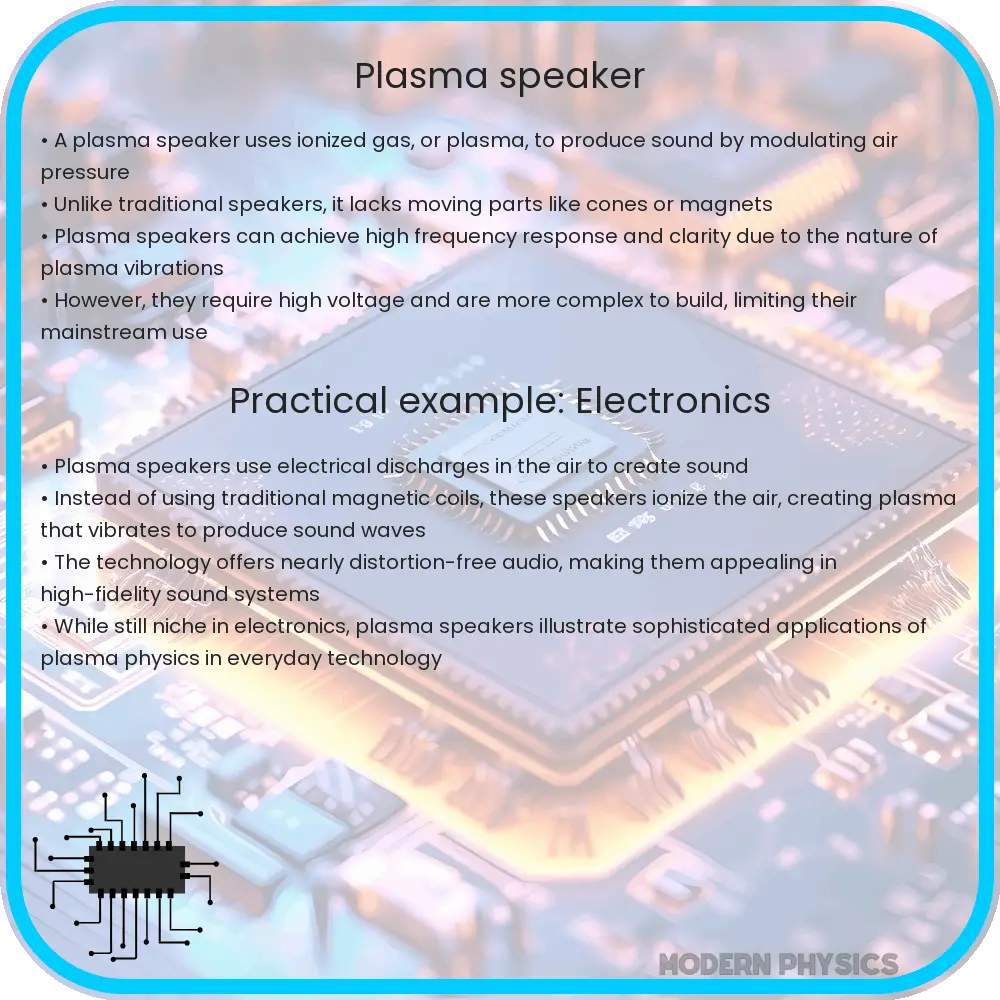Explore the world of plasma speakers, where innovative design meets crisp sound through ionization, offering an unparalleled audio experience with futuristic appeal.

Plasma Speaker: An Electrifying Leap in Audio Technology
The world of audio technology has seen remarkable advancements over the years, but few can stir the sense of awe and curiosity as much as the plasma speaker. Merging the realms of science fiction and high-fidelity sound, plasma speakers offer an electrifying design and innovation that pushes the boundaries of how we experience music and sound. But what exactly is a plasma speaker, and how does it differ from conventional speakers? Let’s dive into the crisp sound and electrifying design that define this innovative audio device.
Understanding Plasma Speakers
At the core of a plasma speaker lies the principle of ionization. Unlike traditional speakers that use magnetic fields to move a diaphragm and produce sound, plasma speakers utilize an electric arc – a plasma – to modulate air molecules directly and create sound waves. This arc is not just any spark; it’s a carefully controlled phenomenon that vibrates at audible frequencies, turning electrical energy into acoustic energy without the need for moving parts.
Key Advantages of Plasma Technology in Audio
- Exceptional Sound Clarity: By eliminating mechanical components, plasma speakers reduce distortion significantly, delivering a level of clarity that audiophiles dream of. The direct conversion of electricity into sound allows for a wider frequency range, ensuring that high notes are crisp and low notes are clear.
- Unique Aesthetic Appeal: The visual aspect of a glowing arc adds a futuristic touch to any setting, making plasma speakers not just an audio device but a piece of art. Their distinctive look is matched by their sound quality, making them a standout choice for enthusiasts looking for something out of the ordinary.
- Innovative Design: The absence of traditional speaker components allows for more creative and compact designs. This flexibility makes plasma speakers an excellent choice for spaces where conventional speakers would be impractical.
The operation of a plasma speaker involves ionizing gases, typically air, to create a conductive medium through which electrical current can flow. This ionization process is achieved by applying a high voltage across a small gap, causing the air in the gap to ionize and form plasma. As the electrical current varies in frequency and amplitude, so does the plasma arc, vibrating the air and producing sound waves.
The Science Behind the Sound
The principle behind plasma speakers is rooted in physics, particularly in the behavior of gases and electrical conductivity. When the gas becomes ionized to form plasma, it creates a medium that can conduct electricity and respond rapidly to electrical changes. This allows the plasma speaker to modulate the plasma arc with audio signals, resulting in sound production. The frequency of the arc’s vibration corresponds to the sound’s frequency, and the amplitude of the vibration determines the sound’s volume.
Challenges and Considerations
Despite their advantages, plasma speakers come with their own set of challenges. The requirement for high voltage and the production of ozone (O3) are significant considerations. High voltage necessitates careful handling and design to ensure safety, while ozone, a byproduct of air ionization, needs to be managed through ventilation or ozone filters to avoid accumulation in enclosed spaces.
Future Prospects and Developments
The ongoing research and development in plasma speaker technology promise even more exciting advancements in the future. Efforts to mitigate ozone production, improve energy efficiency, and further enhance sound quality are underway. As these challenges are addressed, we can anticipate wider adoption of plasma speakers in both professional audio settings and consumer electronics.
Conclusion
Plasma speakers represent a fascinating blend of science and art, offering an unparalleled audio experience with their crisp sound and electrifying design. While they may currently be more of a niche product due to their operational complexities and safety considerations, their unique advantages make them a compelling area of audio technology. As innovations continue to overcome current limitations, plasma speakers could redefine our expectations for high-fidelity sound, combining visual beauty with auditory excellence. The future of audio technology shines brightly with the potential of plasma speakers, promising an exciting era for audiophiles and technology enthusiasts alike.
